|
1876 was a stellar year for the United States.
From its fledgling beginnings in Philadelphia through several
wars and one great divisive internal conflict, the Great
Republic was celebrating its Centennial, and rapidly becoming an
industrial power like no other on earth. The US had seen
its share of bumps along the way. It had taken thirteen years to
finally get our Constitution in place, but against the odds, the
Republic had survived for 100 years, and was ready to celebrate.
That same year, the Winchester Repeating Arms
Company of New haven, Connecticut introduced its first
repeating rifle that really had enough power to compete with the
big Sharps, Remington, Springfield, and
other powerful single shot rifles of the day. Introduced
to the World at the Philadelphia Exposition celebrating the
nationís one-hundredth birthday, Winchesterís new 1876 Model
became known as the Centennial. Up until that time, Winchester
really had no rifles with enough power to reliably take the
nationís largest game, such as bear and bison. The 1876
changed all that, with its introductory cartridge, the .45-75
WCF. This bottle-necked case gave the Centennial rifle as
much power as the government .45-70, but in a rifle that held a
dozen of the big cartridges in its magazine. Winchesterís
earlier Models 1866 and 1873 were dandy rifles, but lacked the
power needed for hunting bison on the Great Plains. Like the
other Winchesters, the Model 1876 used the slick-operating
toggle link action, but on a larger receiver. Also like other
Winchesters, the 1876 was never adopted by the US military, but
the Canadian North West Mounted Police ordered hundreds
of the carbine version, where they were in use for many years.
The 1876 was very popular in the northwest parts
of North America, and several made their way to .Africa and Asia
in the hands of big game hunters. Theodore Roosevelt was
a great proponent of the Model 1876, and used them extensively
in America and Africa. While a lot of shooters today
consider the Ď76 to be too heavy, with most rifle versions
weighing in at around ten pounds, back then most hunters wanted
a powerful repeater that could be carried handily on horseback,
as did lawmen, outlaws, Regulators, and others who chose the big
Winchester.
Original specimens in good condition are
somewhat hard to find, as only about 64,000 were ever built. The
ones that have survived in good condition exhibit excellent
workmanship, as this was Winchesterís top rifle of the day. An
original 1876 in workable condition is prohibitively expensive,
for me at least. The ones that I have seen for sale cost about
as much as a good pickup truck. While the replica Winchester
market is flooded with affordable examples of the Models 1866,
1873, and even the Henry, the Model 1876 has been mostly
ignored, until now.
A few months ago, I was speaking with Nick
Ecker at Charter 2000, the maker of the Charter
revolvers, when he informed me that he was working on importing
a replica of the 1876 Winchester. The manufacturer is Chaparral
Repeating Arms of Italy. He immediately had my undivided
attention. I have always been a fan of that big rifle, and
instantly started begging for a test rifle as soon as production
guns were ready. Like most things in the gun industry, the
wheels of progress turn slowly, especially when import paperwork
and such must be endured. A couple of weeks ago, I learned
that the guns were about to be ready, and I started preparing
ammunition immediately. The final assembly of the rifles is done
in the United States by Charter 2000, in Connecticut, not far
from where the originals were built.
The 1876 is chambered for three of the original
rifleís cartridges: the .45-75, the .45-60, and the .40-60 WCF
cartridges. The rifle that I was expecting to arrive was a
.45-60, so I had prepared cartridge cases by cutting down .45-70
cases to the proper length, and loaded up a quantity of ammo for
the tests using 300 grain cast lead Magnus bullets.
The gun that I received is chambered for the .40-60 cartridge,
so I had to hastily prepare some ammo for that, as I had neither
loaded or ordered any ammo of that type. For those who not
load their own, ammo for all three of these chamberings is
available from Buffalo Arms (www.buffaloarms.com).
Being caught unprepared, I had to go into my stash of new Starline
.40-65 cartridge cases, and I cut them to the proper length for
the .40-60 rifle that had arrived. While the .40-60 has a very
slight bottleneck shape, the cut down .40-65 cases work just
fine. Also being caught without proper .406 diameter lead
bullets, I had to use some .410 diameter 210 grain
semi-wadcutters, which left the loaded cartridge too large to
chamber. Running the first half inch of the loaded cartridges
into a .41 magnum carbide sizer corrected that problem, and the
rounds chambered easily in the Ď76 Chaparral. Mt.
Baldy sells bullets for the Ď76 of the proper .406
diameter, and Lyman makes a suitable mold for those who
like to cast their own, so you will not have to endure the
problems that I did.
Before getting into the shooting results of this
rifle, I suppose a brief description is in order. Upon opening
the soft padded gun case in which the Chaparral was shipped, I
was stunned when I first saw the thing, and it takes a lot
to stun me! Everyone in the hardware store at that time rushed
over to see the rifle, and all were gasping at the beauty and
elegance of the big rifle. I will state right here, that this is
one of the most beautiful rifles that I have ever held in my
hands, and I have held plenty. The wood is downright gorgeous.
It is a highly figured wood with dark grain throughout the
buttstock and forearm. The wood to metal fit is very good. The
case colors are vivid and beautifully patterned. The bluing is
dark, and nicely polished, and the brass cartridge lifter is
highly polished, and furnishes a beautiful contrast to the case
colored receiver. The twenty-eight inch tapered octagon barrel
wears a long range sporting leaf rear sight, and a brass blade
front. The barrel tapers from one inch at the receiver to
eight-tenths of an inch at the muzzle. The straight buttstock
wears a rifle-type case colored steel buttplate that has a
sliding brass cover to contain a sectioned cleaning rod within
the stock. The Chaparral is of the third variation of the
1876 style, meaning that the guide for the dust cover is made
integral with the receiver, instead of screwed on as with the
second variation guns. The full-length magazine on the test
rifle holds twelve of the .40-60 cartridges. I am very impressed
with the fit and finish of the rifle. I was so impressed with
the quality and grade of the wood that I called Nick to
inquire about it. I thought that maybe he had picked it out
special for me. He said that every rifle in that first shipment
had gorgeous wood. Hopefully, that trend will continue. The
Chaparral .40-60 rifle weighs in at just over ten pounds. Mine
weighed 10 pounds, 2.8 ounces, to be exact. The trigger pull
measured a bit heavier than I like, releasing with just over six
pounds of pressure. The action on the Ď76 works extremely
smoothly, especially for someone who is used to working the
lever on more modern lever action designs. There is nothing
quite as smooth as a well-fitted toggle link, and the Chaparral
is fitted well. The gun exhibits excellent craftsmanship.
Shooting the .40-60 Chaparral proved to be a
real pleasure. The loads that I assembled fired the 210 grain
bullet at an average of 1393 feet-per-second, and had an average
deviation of only 2.1, which is extremely consistent. I loaded
twenty-three grains of Hodgdon 4227 powder with a Federal
GM210 primer. Recoil was very mild. Accuracy was good using the
open sights. As it was cold and the wind was howling, I was only
able to shoot the rifle at first at a range of thirty yards,
where it was easy to keep the bullets on target in a tight
one-inch circle. The following day had better weather
conditions, and shooting the Chaparral at 100 yards proved the
accuracy to be about as good as I can shoot open V-notch sights
at that range, displaying groups in the three to three and
one-half inch range. I am certain that the rifle could do better
with a better shooter, but I was well-satisfied with the groups
shown. I also would love to try the rifle with a properly sized
bullet, such as the one offered by Mt. Baldy, and I might get to
do so later, but my deadline for this piece did not allow it for
now.
After my first conversation with Nick about the
new 1876 Chaparral, I was anxious to see how the actual
production guns would turn out, as to fit, finish, accuracy, and
function, as many replica rifles are rather plain. All of my
expectations were greatly exceeded. I had anticipated a rather
unadorned, but functional rifle. The final product is much more
than that. It is an absolutely beautiful, well-fitted, and
accurate rifle. I still want to get my hands on one of these
chambered for the .45-60. If it is the quality of this first
sample gun, I will not be disappointed.
MKS Supply is handling the distribution
of these fine rifles, and as soon as they have the information
on their website, we will add a link here. Several distributors
are already committed to carrying the Chaparral, AccuSport
being one of them.
For a high-quality, beautiful, functional rifle
that just reeks of history, you canít go wrong with one of
these Chaparral 1876 leverguns. I know that I am buying one, and
I canít recommend a gun any higher than that.
Jeff Quinn
UPDATE: Since writing this article, I
have learned that the figure in the wood is enhanced, or
applied, to the surface of a plainer grade of wood. It is still
beautiful wood, as the pictures show, but the surface grain
finish does not run throughout the wood; rather it is a part of
the finishing process. I was fooled until I removed the
buttstock to get to the hammer spring. The wood still looks as
good as ever, but I wanted our readers to know that if the
surface is sanded or reshaped for any reason, the grain does not
run through to the interior of the wood, but is only on the
surface.
  
Got something to say about this article? Want to agree (or
disagree) with it? Click the following link to go to the GUNBlast Feedback Page.
|
|
Click pictures for a larger version.
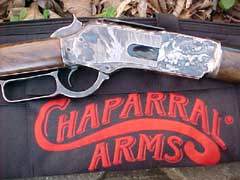
Chaparral Arms Model 1876 Winchester Replica Levergun.
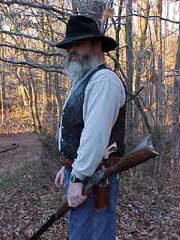
Author's cautiously-high expectations were exceeded by
this beautiful rifle.
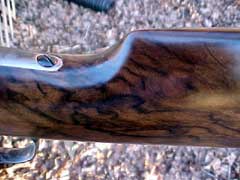
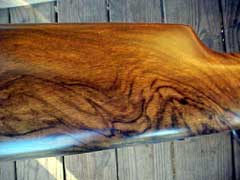
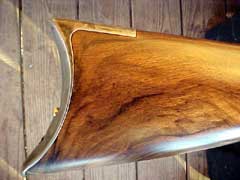
The high-grade wood stock is absolutely gorgeous.
Pictures do not do it justice.
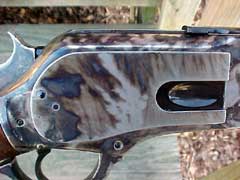
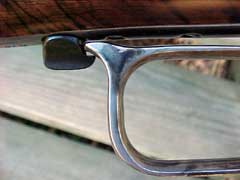
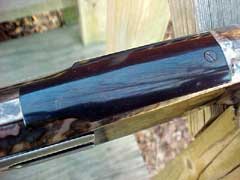

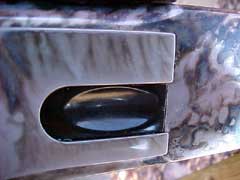
Metal work is superb, with beautifully vivid
antique-looking case colors and highly-polished blue and
brass.
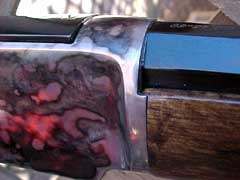
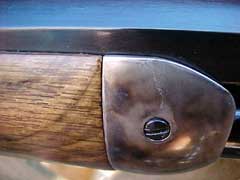
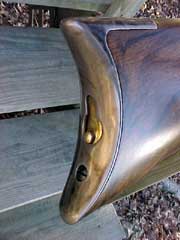
Wood to metal fit is excellent, and indicative of a high
level of craftsmanship.
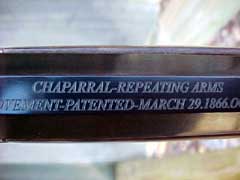

Markings, while obviously not in identical to the
original Winchesters, have a nineteenth-century look.

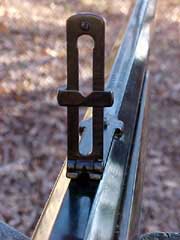
Sights are traditional: dovetailed brass blade front and
"ladder" style rear.
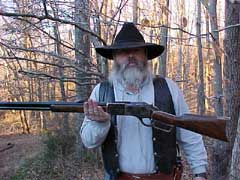
While not a lightweight rifle by any means, the
Chaparral 1876 balances perfectly, just as the originals.
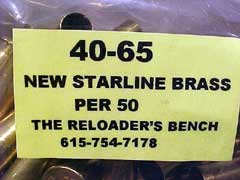
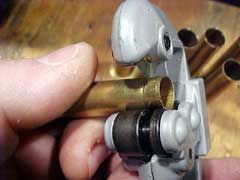
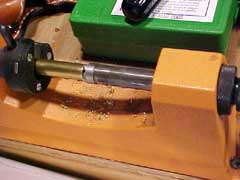

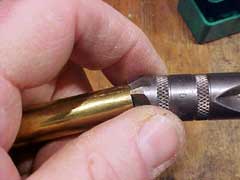
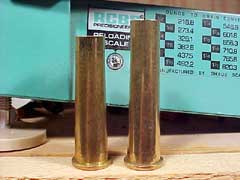
Jeff formed .40-60 cases from new Starline .40-65 brass.
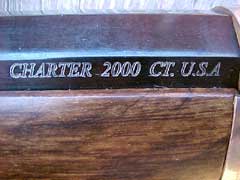
|
![]()